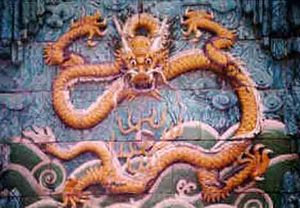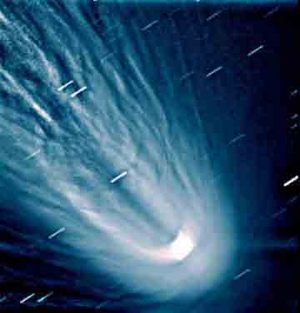Garish and unfounded speculations aside, it is interesting that Comet Holmes, while providing a remarkable cometary "light show" and inciting great interest, never appeared to the naked eye as more than a tiny, luminous "fluff ball" of light. Certainly, without the aid of telescopes and space satellites, its unremarkable glow amongst a vast network of stars and planets would not have captured the average person's attention. Nor would anyone observing it have had any reason to feel terror.
But according to the ancient record, comets have long aroused terror in human beings, and this fear has clearly persisted into modern times. Even the astronomical mainstream recognizes that comets have historically been viewed as portents of destruction. The NASA report "Comets in Ancient Cultures" observes: "Comets have inspired dread, fear, and awe in many different cultures and societies around the world and throughout time. They have been branded with such titles as 'the Harbinger of Doom' and 'the Menace of the Universe.'"
In fact, increasing numbers of scientists may be coming to see that the global theme of the Doomsday comet is not a figment of human imagination, but a universal memory yet to be deciphered. The recent Discover Magazine article "Did a Comet Cause the Great Flood?" discusses the research of Bruce Masse, an environmental archaeologist at Los Alamos National Laboratory. Masse says of ancient petroglyphs depicting coiling serpents, "You can't tell me that isn't a comet." Masse concludes that, perhaps 5,000 years ago, a body three-miles wide smashed into the ocean off the coast of Madagascar. A watery cataclysm ensued, killing roughly eighty percent of the world's population.
But of course, this is not a new idea. In the 17th century, the English theologian and mathematician William Whiston and many of his followers had already linked the Biblical deluge to the arrival of a comet. A poignant illustration of this connection is the 1840 painting by John Martin, "The Eve of the Deluge." It depicts onlookers observing the arrival of a comet, in advance of the Great Flood.
While Masse's theory is surely a step in the right direction, it must ultimately fail, because it does not confront the heart of the ancient message. This message can become comprehensible only when investigators are willing to consider the details provided by the ancient witnesses themselves -- even when these details are uncomfortable to modern science. The evidence must not be examined selectively. Myth counts as evidence when widely separated cultures say precisely the same thing. And if they say the same things on a broad range of details, it then becomes clear that the evidence could not exist without the shared experience that provoked it.

|
| ©Unknown |
| The famous Chinese dragon was characterized by flaming, lightning-like emanations. |
For example, when Masse points to a serpent pictograph and insists it is a comet, that itself is not persuasive at all (and when has an observed comet in modern times ever produced a full spiral?) It is the complete story of the cosmic serpent, reconstructed from the points of agreement from far-flung cultures around the world, that definitively establishes the serpent as a comet image -- from the Egyptian Apep to the Babylonian Tiamat, from the Norse Midgard serpent to the Aztec "Fire Serpent" Xiuhcoatl. But mainstream science has not yet shown either the courage or openness of mind necessary to see this story without ideological prejudice. The truth of the matter is that the lens through which mainstream astronomers and archaeologists consider ancient testimony cannot fail to distort the message.
Astronomers and astrophysicists today still view comets as icy bodies moving through electrically neutral space. To hold to this position, they have steadfastly ignored or dismissed the overwhelming evidence for an electric comet model. And in doing so, they have failed resoundingly to anticipate the accumulating surprises, many of which were predicted by Electric Universe proponent Wallace Thornhill and his colleagues. These surprises include:
Highly energetic supersonic jets exploding from comets' nuclei; the inexplicable confinement of these jets into narrow filaments, spanning great distances, up to MILLIONS of miles, defying the behavior of neutral gases in a vacuum; jets occurring on the dark sides of comet nuclei; comet surfaces with sharply carved relief -- the exact opposite of what astronomers expected under the "dirty snowball" model; unexpectedly high temperatures and X-ray emissions from cometary comas; a short supply or complete absence of water and other volatiles on comets' nuclei; mounting evidence for the production of the radical OH in cometary comas, due to charge exchange with the Sun (the process that misled astronomers into thinking they were seeing evidence of water removed from the surface.); mineral particles that can only be formed under extremely high temperatures -- the last thing one would expect from a chunk of dirty ice arriving from the outermost reaches of the solar system; comets flaring up while in "deep freeze," beyond the orbit of Saturn; comets disintegrating many millions of miles from the Sun; comet dust particles more finely and evenly divided than is plausible for sublimating "dirty ices"; ejection of larger particles and "gravel" that was never anticipated under the idea that comets accreted from primordial clouds of ice, gas, and dust; the unexplained ability of a relatively minuscule comet nucleus to hold in place a highly spherical coma, up to millions of miles in diamater, against the force of the solar wind. (For background on the electric comet, click here)
So we must now ask if the avalanche of recent comet discoveries, ranging from "surprising" to "astonishing," can help us to understand the comet-like "dragon" of world mythology?

|
| ©Unknown |
| Enhanced image of comet Hale-Bopp, 1997 |
Without question, the dragon is virtually always connected to undeniably ELECTRICAL events in the sky. In its attack, lightning and thunder shake the earth. The ancient Anzu epic from Mesopotomia, depicting the fiery battle of the dragon and the god Ninurta, states, "Clouds of death rained down, an arrow flashed lightning. 'Wizzed' the battle force roared between them." In Hesiod's well-known account of the dragon Typhon's attack, the earth "groaned" beneath the god Zeus, "and the heat and blaze from both of them were on the dark-faced sea, from the thunder and lightning of Zeus and from the flame of the monster, from his flaming bolts, and from the scorch and breath of his storm winds."
The Sumerian texts describe the goddess Inanna as a blazing, destructive celestial force: "Like a dragon you have deposited venom on the land...raining the fanned fire down upon the nation...With a roaring storm you roar...devastatrix of the lands...Mankind comes before you in fear and trembling at your tempestuous radiance.
The Babylonian texts depict the goddess Ishtar in her terrible aspect: "...shining torch of heaven and earth...furious irresistible onslaught... I rain down like flames..."
Identical imagery occurs in Egyptian texts. The goddess Sekhmet becomes the Uraeus serpent raging in the sky: "A flame of fire in her tempest...the fear of me is in their hearts...the awe of me is in their hearts...No one at all can approach her...The streams behind her are flames of fire."
These are just a few instances -- out of hundreds -- pointing to the electrical properties of the cosmic serpent or dragon. If astronomers, scientists, and archaeologists are truly interested in human memories of cometary catastrophe, it is intellectually indefensible to ignore the overwhelming consensus of the testimony. And this consensus leads inexorably to decades of evidence from plasma experiments (a field largely ignored by mainstream astronomers).

|
| ©Unknown |
| Left: An electric spark in a laboratory; Right: Enigmatic petroglyph on cave wall in Chaco canyon in Mexico. |
Electrified plasma -- a medium defined by the presence of charged particles -- will naturally generate filamentary, twisted, spiraling, and life-like structure. This characteristic of electric currents is also seen in the so-called "magnetic ropes" recently observed by the THEMIS spacecraft connecting the Sun and the earth (see The Electric Sun/Earth Connection). The dragon's effusive feathers, long-flowing beard, streaming mane or hair, fiery breath and "lightning" like emanations -- all ancient hieroglyphs for the comet -- are the well-documented characteristics of plasma discharge. In its electric displays, an energetic comet gives us the perfect corollary to the cosmic dragon.
But if we are permitted to draw conclusions from the ancient testimony, the tale of the Doomsday comet surely does not end with the cosmic serpent/dragon. An abundance of testimony reveals, for example, an inseparable connection of the attacking serpent or dragon with the "terrible aspect" of the mother goddess, precisely as indicated by more than one of the quotes above. This goddess figure stands at the heart of the ancient cultures -- an object of both reverence and terror. And in fact, innumerable goddesses acquire a comet-like appearance -- wildly disheveled hair, flaming countenance, accompanied by chaotic hordes or clouds of chaos, threatening to destroy the world. The moment one accepts the compelling memories of a serpent or dragon's assault, it is no longer reasonable to exclude the equally compelling ancient profiles of the mother goddess. As we shall report in the conclusion of this piece, the ancients' story of the Doomsday comet, when fully appreciated, will change our view of human history, and alter the course of science as well.



Makes one wonder just what Perseus was up against when he cut off the head of Medusa!